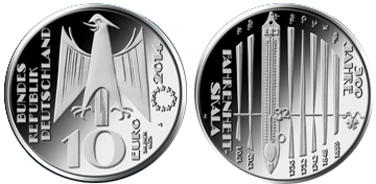Germany Wins “Most Historically Significant Coin” for 2014 dated COTY
Germany’s 10-euro silver coin commemorating the 300th anniversary of Daniel Fahrenheit’s invention of the mercury thermometer (KM#332 & #332a) was named the “Most Historically Significant Coin” in the Krause Coin of the Year Award for coins dated 2014. The award honors coins commemorating historic events that took place within the last 100 years.

Engraved by Victor Benjamin Huster, the coin marks the 300th anniversary of the first mercury thermometer with a temperature scale. In 1714, Dutch-German-Polish physicist Daniel Gabriel Fahrenheit created the world’s first mercury thermometer. Fahrenheit divided the freezing and boiling points of water into 180 degrees. He set 32°F as the freezing point of water, while water boils at 212°F. Interestingly, 0°F reflects the temperature of an equal mixture of water, ice, and salt.
The coin’s obverse features the Coat of Arms of Germany, which is a black eagle. It also includes the following inscriptions: BUNDES REPUBLIK DEUTSCHLAND 10 EURO Silver 625 2014 J
The reverse features the Fahrenheit scale and the following lettering: VH 1701 °N 1702 °Rø °F 1730 °Re 1732 °D 1742 °C 1848 K 1859 °Ra 32 0. The inscription “FAHRENHEIT SKALA” is located near the left edge. “300 JAHRE” (meaning “300 Years”) is inscribed towards the right edge.
The coin also includes edge lettering, “EIN MEILENSTEIN DER MESSTECHNIK,” which translates to “Milestone in Measurement Engineering.”
The 10-euro silver coins were struck at the Hamburg Mint. Each coin weighs 16 grams and measures 32.5 mm in diameter. 2000 were struck in silver proof. 185,000 were struck in copper-nickel uncirculated.
